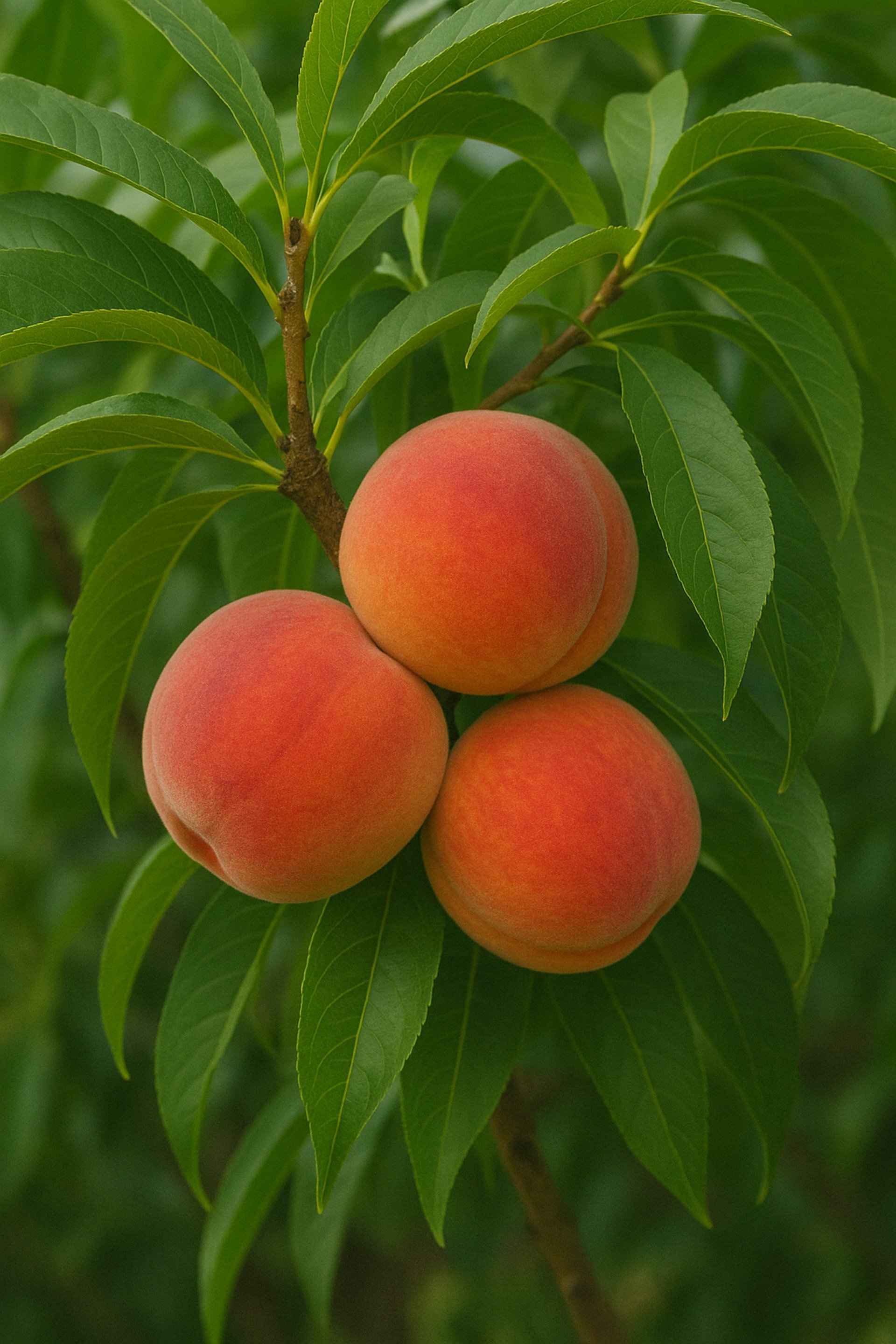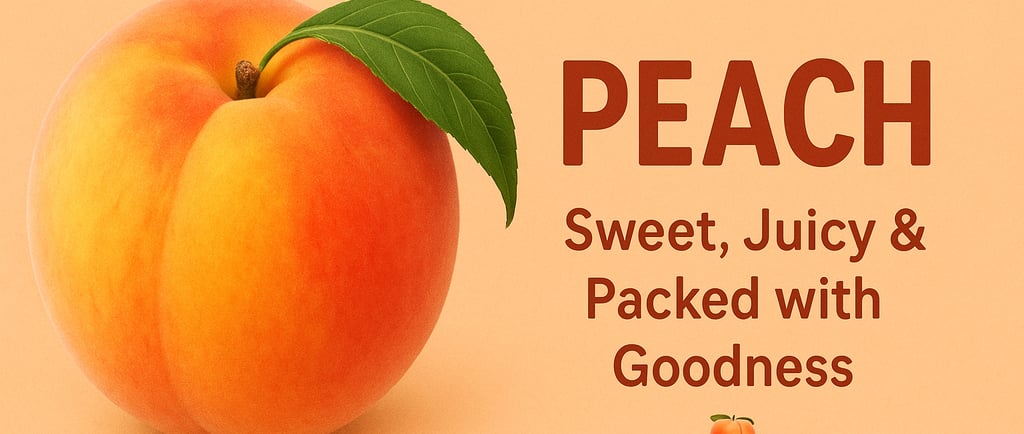🌿 GROWPlantWell – Nurture Nature, Transform Your Space 🌿

🍑 The Peach: Sweet, Juicy & Packed with Goodness, and Cultivation Tips
Discover the sweet world of peaches 🍑 — their health benefits, nutritional value, growing tips, common pests & diseases (including fruit fly), plus Q&A for peach lovers
Grow Plant Well
8/12/20253 min read


🌟 Introduction
Peaches (Prunus persica) are one of the world’s favourite summer fruits — loved for their juicy sweetness, soft fuzzy skin, and refreshing flavour. Originating from China over 8,000 years ago, peaches are now grown worldwide and enjoyed fresh, cooked, or preserved. Beyond their irresistible taste, peaches are full of essential vitamins, minerals, and antioxidants that benefit your health.
🥗 Nutritional Benefits of Peaches
Peaches are not just tasty — they’re a powerhouse of nutrition:
🍊 Vitamin C – Boosts immunity & promotes glowing skin
💪 Potassium – Supports heart health & muscle function
🧠 Antioxidants – Protects cells from free radical damage
🌾 Dietary Fibre – Aids digestion & supports gut health
💧 Hydration – High water content helps keep you refreshed
❤️ Health Benefits of Eating Peaches
🌿 Supports Healthy Skin – Antioxidants and Vitamin C fight skin damage and promote collagen production.
🫀 Heart Health – Potassium and fibre work together to regulate blood pressure.
⚡ Boosts Immunity – Rich in vitamins that strengthen the body’s defence system.
🥗 Aids Digestion – Fibre helps regulate bowel movements and supports gut microbiome.
🛡️ Anti-inflammatory Effects – Bioactive compounds help reduce inflammation.
🍽️ How to Enjoy Peaches
Peaches are incredibly versatile:
🥤 Blend into smoothies for a refreshing drink
🥧 Bake into pies, tarts, or crumbles
🥗 Add slices to salads for a sweet touch
🍯 Grill them for a caramelised dessert
🍹 Infuse into iced tea for a fruity twist
🌱 Growing Peaches at Home
If you have a sunny backyard or garden, you can grow peaches yourself!
Tips for Growing Peaches:
🌞 Full Sunlight – At least 6–8 hours a day
🌱 Well-Drained Soil – Prevents root rot
✂️ Regular Pruning – Encourages better fruit production
💧 Consistent Watering – Especially during dry seasons
🐛 Common Insect Pests of Peaches
🍑 Oriental Fruit Moth (Grapholita molesta)
Damage: Larvae bore into shoots and fruit, causing wilting and fruit drop.
Control: Use pheromone traps, prune infected shoots, and apply organic or registered insecticides.
🪳 Peach Twig Borer (Anarsia lineatella)
Damage: Larvae tunnel into twigs and fruit, leading to dieback and rotting.
Control: Winter pruning to remove overwintering larvae, use biological controls like beneficial wasps.
🐜 Aphids (Myzus persicae and others)
Damage: Suck plant sap, deform leaves, and transmit viral diseases.
Control: Encourage ladybirds 🐞, use neem oil sprays.
🪲 Plum Curculio (Conotrachelus nenuphar)
Damage: Small crescent-shaped scars on fruit; larvae feed inside, causing fruit drop.
Control: Remove dropped fruit, use traps, apply protective sprays.
🪰 Fruit Fly (Bactrocera tryoni – Queensland Fruit Fly, Ceratitis capitata – Mediterranean Fruit Fly)
Damage: Female lays eggs inside ripening fruit; larvae feed on flesh, causing soft spots, rotting, and premature fruit drop.
Control:
🧴 Protein Baits & Lures – Attract and kill adults before they lay eggs
🛡 Fruit Bagging – Protects fruit from egg-laying
🧹 Hygiene – Remove and destroy fallen or infested fruit
🪤 Trapping – Use pheromone or food-based traps to monitor and reduce populations
🦠 Common Diseases of Peaches
🍄 Peach Leaf Curl (Taphrina deformans)
Symptoms: Thickened, curled, reddish leaves in spring.
Prevention: Apply copper or lime sulphur spray during dormancy; remove infected leaves.
🧫 Brown Rot (Monilinia fructicola)
Symptoms: Brown, sunken spots on fruit; rapid rotting; fuzzy fungal growth.
Prevention: Prune to improve air circulation, remove mummified fruit, apply fungicides.
🦠 Bacterial Spot (Xanthomonas campestris pv. pruni)
Symptoms: Small dark spots on leaves and fruit; fruit cracking.
Prevention: Use resistant varieties, avoid overhead watering, apply copper sprays.
🌱 Powdery Mildew (Podosphaera pannosa)
Symptoms: White, powdery coating on leaves, buds, and young fruit.
Prevention: Maintain good airflow and use sulfur-based sprays.
🛡️ Integrated Pest & Disease Management Tips
🔄 Crop Rotation: Avoid planting peaches in the same spot repeatedly.
🌬️ Air Circulation: Prune to keep the canopy open.
🧹 Sanitation: Remove fallen fruit, leaves, and debris regularly.
🐞 Biological Control: Encourage beneficial insects like ladybirds and lacewings.
📅 Seasonal Sprays: Apply dormant sprays in winter for disease prevention.
🌍 Fun Facts About Peaches
Originated in China, where they symbolise longevity and immortality
🍑 The fuzz on peaches helps protect them from insects and rot
🌸 Peach blossoms are as beautiful as cherry blossoms
❓ Q&A About Peaches
Q1: Are peaches good for weight loss?
✅ Yes! Peaches are low in calories, high in fibre, and naturally sweet — making them a healthy snack that supports weight management.
Q2: How do I know when a peach is ripe?
✅ A ripe peach will give slightly when gently squeezed, have a sweet aroma, and show vibrant colour without green patches.
Q3: Can I grow peaches in pots?
✅ Absolutely. Choose a dwarf peach variety, use a large pot (at least 40cm wide), and ensure plenty of sunlight.
Q4: How do I prevent fruit fly in peaches?
✅ Use a combination of baiting, trapping, fruit bagging, and garden hygiene to stop fruit flies from damaging your crop.
Q5: Are peach skins edible?
✅ Yes, peach skins are edible and full of antioxidants, but wash thoroughly before eating to remove any pesticide residues.